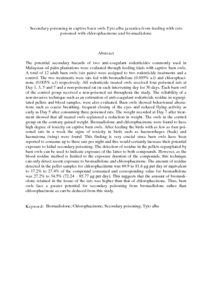Citation
Salim, Hasber and Mohd Noor, Hafidzi and Hamid, Noor Hisham and Omar, Dzolkifli and Kasim, Azhar and Zainal Abidin, Cik Mohd Rizuan
(2014)
Secondary poisoning in captive barn owls Tyto alba javanica from feeding with rats poisoned with chlorophacinone and bromadiolone.
Journal of Oil Palm Research, 26 (1).
pp. 62-72.
ISSN 1511-2780
Abstract
The potential secondary hazards of two anti-coagulant rodenticides commonly used in Malaysian oil palm plantations were evaluated through feeding trials with captive barn owls. A total of 12 adult barn owls (six pairs) were assigned to two rodenticide treatments and a control. The two treatments were rats fed with bromadiolone (0.005% a.i) and chlorophacinone (0.005% a.i) respectively. All rodenticide treated owls received four poisoned rats at Day 1, 3, 5 and 7 and a non-poisoned rat on each intervening day for 30 days. Each barn owl of the control group received a non-poisoned rat throughout the study. The reliability of a non-invasive technique such as an estimation of anti-coagulant rodenticide residue in regurgitated pellets and blood samples, were also evaluated. Barn owls showed behavioural aberrations such as coarse breathing, frequent closing of the eyes and reduced flying activity as early as Day 5 after consuming three poisoned rats. The weight recorded at Day 7 after treatment showed that all treated owls registered a reduction in weight. The owls in the control group on the contrary gained weight. Bromadiolone and chlorophacinone were found to have high degree of toxicity on captive barn owls. After feeding the birds with as few as four poisoned rats in a week the signs of toxicity in birds such as haemorrhages (beak) and haematoma (wing) were found. This finding is very crucial since barn owls have been reported to consume up to three rats per night and this would certainly increase their potential exposure to lethal secondary poisoning. The detection of residue in the pellets regurgitated by barn owls can be used to indicate exposure of the latter to both compounds. However, as the blood residue method is limited to the exposure duration of the compounds, this technique can only detect recent exposure to bromadiolone and chlorophacinone. The amount of residue detected in the pellet samples for chlorophacinone was 69.9 to 81.6 μg per day or equivalent to 17.2% to 27.4% of the compound consumed and corresponding value for bromadiolone was 27.2% to 34.5% (72.24 – 85.77 μg per day). This suggests that the amount of bromadiolone retained in the tissue of the rats was higher than that of chlorophacinone. Thus, barn owls face a greater potential for secondary poisoning from bromadiolone rather than chlorophacinone as can be deduced from this study.
Download File
![[img]](http://psasir.upm.edu.my/35327/1.hassmallThumbnailVersion/Secondary%20poisoning%20in%20captive%20barn%20owls%20Tyto%20alba%20javanica%20from%20feeding%20with%20rats%20poisoned%20with%20chlorophacinone%20and%20bromadiolone.pdf)  Preview |
|
PDF (Abstract)
Secondary poisoning in captive barn owls Tyto alba javanica from feeding with rats poisoned with chlorophacinone and bromadiolone.pdf
Download (151kB)
| Preview
|
|
Additional Metadata
Actions (login required)
 |
View Item |

